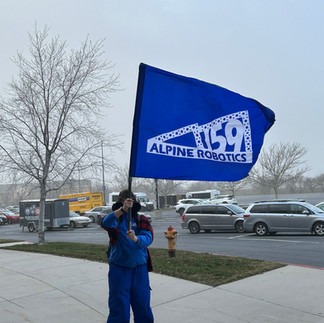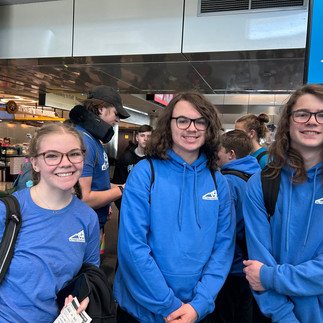159 Alpine Robotics Goes to Utah
- Austin Eide

- Mar 25, 2024
- 4 min read
Previously, 159 Alpine Robotics had been making progress in the design phase for the 2024 Build Season. By early February, not much mechanical work had been completed on this year's robot. The team was in a good position for the Denver competition after Spring Break, but a sudden development put things into overdrive. In mid February, the team learned they had been accepted to the Salt Lake City Regional Competition. This competition, along with being in another state, was also the first week of March. So instead of just under two months, 159 now had just three weeks to finish their robot. They were ultimately successful, but let's look at the journey the team took to accomplish this.

After learning of the Utah competition, Alpine Robotics had to get going in a hurry. At the time, only the drive train and electronic components had been assembled. CAD (Computer Aided Design) of the robot had still yet to be finished. One of the most important parts of the robot was the shooter and intake. As the entire robot hinged on the success of intaking and shooting game pieces, these had to be designed to near perfection. This task was undertaken by Team Captain Jenna Monroe. As head of the CAD department, Monroe had extensive knowledge of Solidworks, the main CAD software used by the team. The design of these plates were complex, yet allowed for proper assembly and execution of the required tasks. As parts were being finished in design, the Shop team had their work cut out for them.

Due to the complexity of the parts, many of them were machined on the HAAS Mini Mill, Team 159's CNC (Computer Numerical Control). This complex machine requires knowledge of CAD, Shop, and Programming to properly run. One student on the team, Thomas Damiana, has mastered these skills. His ingenuity and genius design have gifted the team with spectacular results. One of these parts are the bumper mounts. These mounts look and function professionally, showcasing Damiana's skill when it comes to machining.
Once many of these parts were either machined in house or ordered, it was time to assemble the robot. The team had settled on a rather simple design, where the game pieces were picked up, transported, and dispensed in the same mechanism. Despite the simplicity of design, assembly of the robot proved to be difficult. Many components required precise lining up, measuring, and proper placement to successfully operate.

After assembly, it was time for Programming. During competition, robots have fifteen seconds to operate autonomously, without human control. This can often make or break the match, meaning the robot's programming needs to be solid. Previously, many aspects of the programming have been done by senior members of the team. This year, Andrew Lewis, a junior, stepped up big time. He worked through a majority of build season on autonomous and teleoperated code for the robot, giving this year's bot a great sense of control.
With all of these aspects completed, 159 Alpine Robotics was ready for Utah. Departing from Denver on February 28th, the team was ready for its Week One Competition. After the first day of practice matches, a few problems had arisen. Some small mechanical problems and coding issues led to less than optimal matches, but the team countered well to the adversity. Midway through Friday the 29th, however, the team noticed a massive problem. The entire arm, which supported the shooter, had bent downwards. This resulted in both shooting and intake failures during matches, severely hurting the team's chances of making the playoffs. After conferring, members attempted to fix the problem with the only materials available to them. With limited space in the Pit, minimal supplies had been packed. Thankfully, the team had the materials to put together a quick fix that stopped the arm from bending. With this repair, Alpine Robotics was ready for the final day of competition. Unfortunately, Mother Nature had other ideas. With a massive snowstorm approaching, the team decided to leave the competition early in order to beat the storm. Despite this, Team 159 ranked 26th out of 46 teams prior to disqualification.
With knowledge gained and further design improvements made, 159 Alpine Robotics was ready for the Denver Competition on March 21st. If you want to watch their progress, check out The Blue Alliance.
Top Left to Bottom Right: Drive Team prepares for their first match. Human Player Paul Olson throws a note. Team Mentor Alan Charters leads Team 159 onto the plane for Utah. Drive Team finishes setting up the pit. Eli Golly bravely holds the flag during the storm. Jenna Monroe, Austin Eide, and Gibson Wessel prepare to board the plane.
Bio:
Austin Eide is currently a junior at Poudre High School. This will be his first year writing for the Poudre Press. He enjoys playing trumpet in Pep Band and is also Captain of the Build Team for 159 Alpine Robotics. Austin also loves building with LEGO and making stop motion movies on YouTube. His blog is dedicated to music, hockey, band, and more!
.png)















Comments